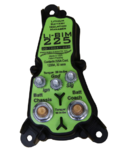If you are using lithium batteries you need a specialized charger. As rajivers stated you can't charge a lithium battery, at least not if you want the battery to last, with an alternator or a dumb charger. Lithium batteries require a somewhat specialized charge curve and then at a preset point you shut the charger off. My charger shuts off when the pack reaches 53 Vdc and the current decreases to about 3A. If you try and use a dumb lead acid charger you will eventually over charge the cells which will lead to premature failure.
The only reason I went with 48V, is because I already had a
48V lithium charger. To charge this pack I simply unplug it from the lawn mower pack and plug it into the pack for the Alta off grid charger. Using the existing charger saved me $500-600. If I was building an off grid setup without that consideration, I would go to a higher voltage. A higher voltage reduces the amount of current required for a given power output. Lower current reduces the wire size and also losses at all the connections, and there are lots of connections in these systems. The losses at each connection go up exponentially with increases in current so less current is good. There's a reason most EVs produced now are 350V+ and going to higher voltages. The
Porsche Mission e reportedly has an 800Vdc high voltage pack. If you are building the system from scratch, use a voltage as high a voltage as you are comfortable with. If you try to make 2500W with 12Vdc you are looking at around 210A which is a lot of current. I would try and avoid that.
If you are shooting for max efficiency, you probably want have your pack voltage approximately equal to the peak voltage of your inverter output. This will minimize amount of voltage boosting that your system needs to do to get the desired output. To get the peak voltage of an AC waveform multiply the RMS voltage, 120 Vac in the US, by 1.414. In the US that will give you a value of about 170V and 340V for 120Vac and 240Vac respectively. I am
not encouraging anyone to build a 340v off grid system, just saying it would be more efficient, but higher voltage within reason, are better. For an off grid system, 48V is adequate. Personalty, I would rather be at 120 if I had the choice. My car is at 155 Vdc/700A so I am more comfortable with higher voltages and currents than most.

 , but not really that much ($665 plus shipping). The
, but not really that much ($665 plus shipping). The 